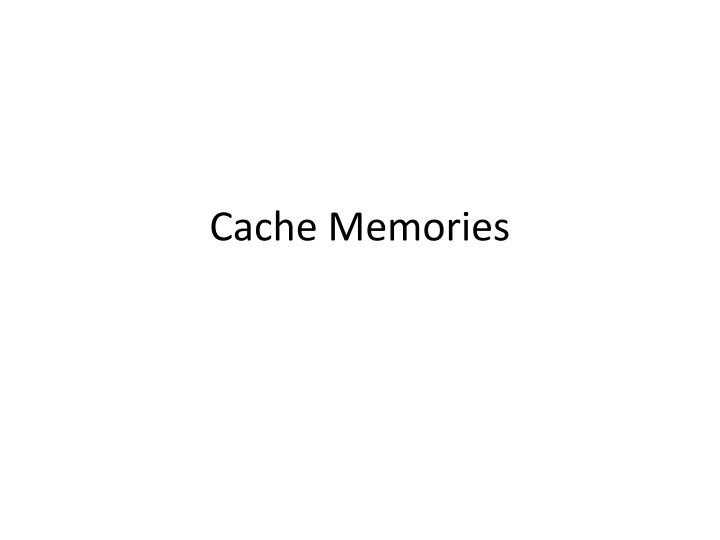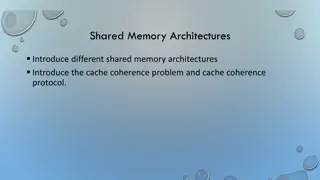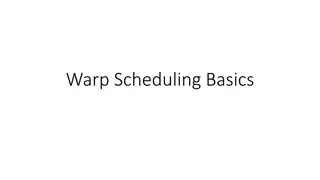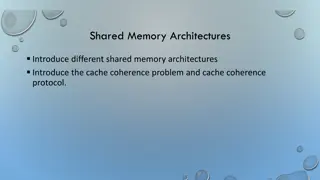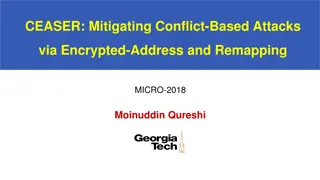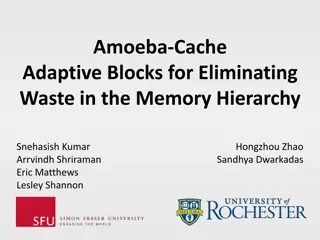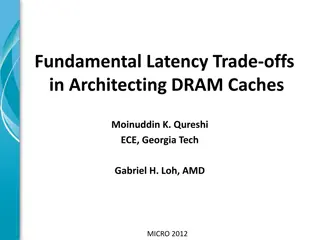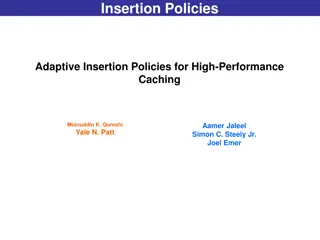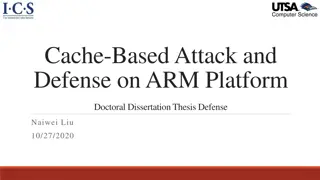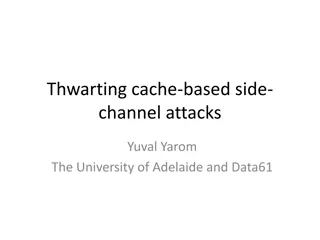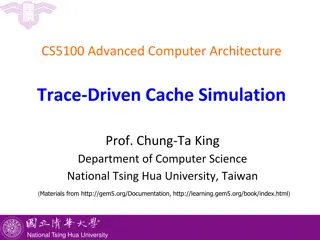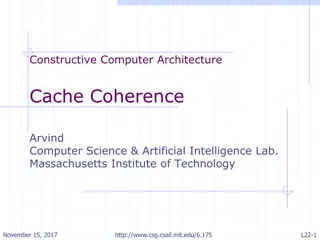Cache Memories: Overview and Concepts
Delve into the world of cache memories with insights into organization, set associativity, cache misses, and parameters. Explore various cache types and sizes, including direct-mapped and set-associative caches. Learn about the Three Cs of Cache Miss Terms and how they impact cache performance.
Download Presentation

Please find below an Image/Link to download the presentation.
The content on the website is provided AS IS for your information and personal use only. It may not be sold, licensed, or shared on other websites without obtaining consent from the author.If you encounter any issues during the download, it is possible that the publisher has removed the file from their server.
You are allowed to download the files provided on this website for personal or commercial use, subject to the condition that they are used lawfully. All files are the property of their respective owners.
The content on the website is provided AS IS for your information and personal use only. It may not be sold, licensed, or shared on other websites without obtaining consent from the author.
E N D
Presentation Transcript
Cache Organization -- Recap A typical cache has three dimensions tag index block offset tag data tag data tag data tag data Number of sets (cache size) tag data tag data tag data tag data tag data tag data tag data tag data Blocks/set (associativity) . . . tag data tag data tag data tag data Bytes/block (block size)
Putting it all together 64 KB cache, direct-mapped, 32-byte cache block 31 30 29 28 27 ........... 17 16 15 14 13 12 11 10 9 8 7 6 5 4 3 2 1 0 tag index word offset 11 16 tag data valid 0 1 2 2 K cache blocks/sets 64 KB / 32 bytes = ... ... ... ... 2045 2046 2047 256 = 32 hit/miss
A set associative cache 32 KB cache, 2-way set-associative, 16-byte blocks 31 30 29 28 27 ........... 17 16 15 14 13 12 11 10 9 8 7 6 5 4 3 2 1 0 tag index word offset 10 18 valid tag data tag data valid 0 1 2 32 KB / 16 bytes / 2 = 1 K cache sets ... ... ... ... 1021 1022 1023 = = hit/miss
Three Cs (Cache Miss Terms) Compulsory Misses: Cold start misses (caches do not have valid data at the start of the program) 0x1234 Processor Cache 6
Three Cs (Cache Miss Terms) Capacity Misses: Increase cache size 0x1234 0x5678 0x91B1 0x1111 Processor Cache 7
Three Cs (Cache Miss Terms) Conflict Misses: Increase cache size and/or associativity. Associative caches reduce conflict misses 0x1234 0x5678 0x91B1 0x1111 Processor Cache 8
Cache Parameters Cache size = Number of sets * block size * associativity 128 blocks, 32-byte blocks, direct mapped, size = ? 128 KB cache, 64-byte blocks, 512 sets, associativity = ?
Sample Problem A cache has a capacity of 32 KB and 256-byte lines. On a machine with a 32-bit virtual address space, how many bits long are the tag, set, and offset fields for A direct-mapped implementation? A four-way set-associative implementation? A fully-associative implementation? Address Tag Set Offset
Sample Problem Version II A cache has a capacity of 32 KB and 256-byte in a set. On a machine with a 32-bit address space, how many bits long are the tag, set, and offset fields for A direct-mapped implementation? A four-way set-associative implementation? A eight-way set-associative implementation? Address Tag Set Offset
Another example 16 KB, 4-way set-associative cache, 32-bit address, byte- addressable memory, 32-byte cache blocks/lines how many tag bits? Where would you find the word at address 0x200356A4? index tag data tag data tag data tag data
PIRW Placement Identification Replacement Writes
Replacement Policies for Associative Caches Least-Recently-Used (LRU): Evict the line that has been least recently referenced Need to keep track of order that lines in a set have been referenced Overhead to do this gets worse as associativity increases Random: Just pick one at random Easy to implement Slightly lower hit rates than LRU on average Not-Most-Recently-Used: Track which line in a set was referenced most recently, pick randomly from the others Compromise in both hit rate and implementation difficulty Virtual memories use similar policies, but are willing to spend more effort to improve hit rate 14
LRU: Precise Tracking Precise LRU tracking requires a stack for each set When a block is accessed by the processor, check if its name is in the stack. If so, remove it from the stack. Push the name of block at the top of the stack The position (depth) of a block name in the stack gives the relative recency of access to this block compared to others For a 4-way set associative cache with blocks A, B, C, D. Assume a sequence of accesses C, D, A, B, A, C, B, D Assume that the stack is initially empty, the configuration of the stack after each access would be [C,-,-,-], [D, C,-,-], [A, D, C,-], [B, A, D, C], [A, B, D, C], [C, A, B, D], [B, C, A, D], [D, B, C, A] The one on the right most position (bottom of the stack) is the least recently used Each name takes two bits, so the stack is an 8-bit register with associated logic (Slog2S where S is associativity) 15
LRU Example MRU-1 LRU+1 LRU MRU A B C D Access C C A B D Access D D C A B Access E MISS, replacement needed E D C A Access C C E D A MISS, replacement needed Access G G C E D 16
LRU From Hardware Perspective LRU Way3 Way2 Way1 Way0 State machine Access update Access D A B C D LRU policy increases cache access times Additional hardware bits needed for LRU state machine
LRU: Approximate Tracking (Pseudo- LRU) LRU stacks expensive to implement at high S Most caches use approximate LRU A popular approach uses S-1 bits for an S-way cache The blocks are hierarchically divided into a binary tree At each level of the tree, one bit is used to track the least recently used For a 4-way set associate cache, blocks are first divided into two halves, each half has two blocks The 1st bit tracks the more recently used half The 2nd bit (3rd) tracks the more recently block in the first (second) half The one to replace is the less recently used block in the less recently used half used in the CPU cache of many commercial processors 18
Pseudo LRU Algorithm (4-way SA) Tree-based O(N): 3 bits for 4-way Cache ways are the leaves of the tree Combine ways as we proceed towards the root of the tree AB/CD bit (L0) A/B bit (L1) C/D bit (L2) Way A Way B Way C Way D Way3 Way2 Way1 Way0 A B C D
Pseudo LRU Algorithm AB/CD bit (L0) Less hardware than LRU & Faster than LRU A/B bit (L1) C/D bit (L2) Way A Way B Way C Way D L2L1L0 = 010, a way needs to be replaced, which way would be chosen? L2L1L0 = 000, there is a hit in Way B, what is the new updated L2L1L0? Replacement Decision AB/CD AB LRU update algorithm CD AB AB/CD CD L2 X X 1 L1 1 0 X L0 1 1 0 Way to replace Way A Way B Way C Way hit Way A Way B Way C L2 --- --- 0 L1 0 1 --- L0 0 0 1 0 X 0 Way D Way D 1 --- 1
LRU Algorithms True LRU Expensive in terms of speed and hardware Need to remember the order in which all N lines were last accessed N! scenarios O(log N!) O(N log N) LRU bits 2-ways AB BA = 2 = 2! 3-ways ABC ACB BAC BCA CAB CBA = 6 = 3! Pseudo LRU: O(N) Approximates LRU policy with a binary tree
A Sample Replacement Policy Question A byte-addressable computer has a small 32-byte cache. Assume 4-byte cache lines. When a given program is executed, the processor reads data from the following sequence of hex addresses: 200, 204, 208, 20C, 2F4, 2F0, 200, 204, 218, 21C, 24C, 2F4. This pattern is repeated four times. (a) Show the contents of the cache at the end of each pass throughout this loop if a direct-mapped cache is used. Compute the hit rate for this example. Assume that the cache is initially empty. (b) Repeat part (a) for a fully-associative cache that uses the LRU-replacement algorithm. (c) Repeat part (a) for a fully-associative cache that uses the approximate LRU replacement algorithm. 24
You should be able to complete the answer 200, 204, 208, 20C, 2F4, 2F0, 200, 204, 218, 21C, 24C, 2F4 (Hex Address) 4-byte blocks so block address sequence in Hex is 80, 81, 82, 83, BD, BC, 80, 81, 86, 87, Direct mapped, 8 blocks 1000 0000, 1000 0001, 1000 0010, 1000 0011, 1010 1101, 1010 1100, 1000 0000, 1000 0001, 1000 0110, 1000 0111, For direct map, there is no room for policy Complete your answer For fully associative cache, it is really an 8-way, 1-set cache, all block address bits are used Complete your answer 25
Another Question Consider a 128 byte 2-way set associative write- back cache with 16 byte blocks. Assume LRU replacement and that dirty bits are used to avoid writing back clean blocks. Complete the table below for a sequence of memory references (occurring from left to right). Address (in decimal): 064 032 064 000 112 064 128 048 240 000 read/write: r r r r w w r r r w Assume that cache starts empty
You should complete the answer 16 byte blocks, 4 LSB byte offset V D Tag Data V D Tag Data 064 032 064 000 112 064 128 048 240 000 There are 4 sets with 2 blocks each Block Addr. 4 2 4 0 7 4 8 R/W R R R R W W R R R W Set# 0 2 0 0 3 0 Tag 1 0 1 0 1 1 H/M M M H M Write back? N N 27
